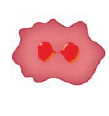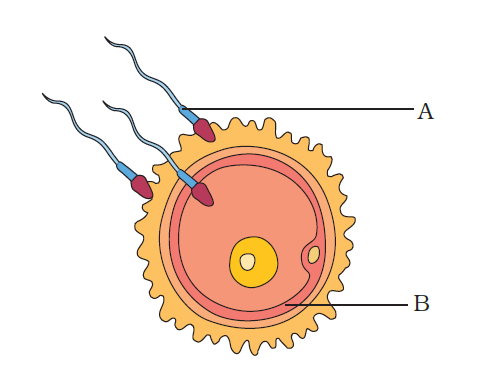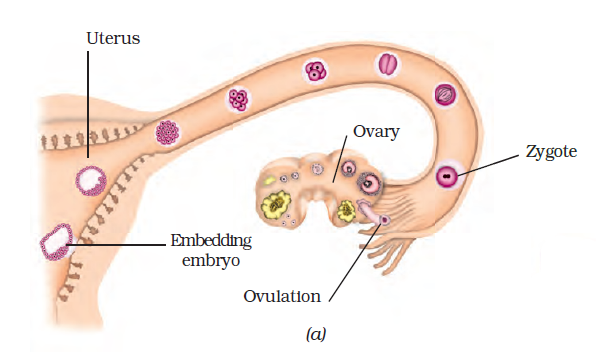Table of Contents
The NCERT Solution for Class 8 Science Chapter 9 is a valuable resource for students in Class 8. Infinity Learn provides these NCERT Exemplar Solutions to assist students in gaining an understanding of the topic and effectively preparing for the examination. Students may also benefit from using NCERT Exemplar Solutions Class 8 Science Chapter 9 to familiarise themselves with the syllabus and test material. All of the exercise questions in Chapter 9 of the Class 8 Science textbook are answered in NCERT Exemplar Solutions. These are created by professional educators to help you understand all of the concepts covered in the chapter. Now you may get the free PDF.
Infinity Learn is a website that offers students free NCERT Exemplar Solutions and other study tools. Students looking for better solutions can obtain Class 8 Maths NCERT Exemplar Solutions to aid in their revision.
Class 8 Science NCERT Exemplar Solutions Chapter 9 – Animal Reproduction
Our website and app make it very simple to acquire NCERT Solution for Chapter 9 Reproduction in Animals Class 8 Chapter 9 PDF. The part on animal reproduction in NCERT Class 8 Science is fascinating. The item provides information on several types of duplication and illustrates them with diagrams. Students’ knowledge will be enhanced via assignments included in the curriculum, which will help them score higher on exams. Biology is a subject that is purely theoretical. As a result, it is extremely difficult for pupils to retain all of the concepts presented in the syllabus. NCERT Solution uses a new mastering technique to help you comprehend and memorize Biology ideas, making it easier for you to understand.
Access Answers to the NCERT Exemplar Class 8 Science Chapter 9 – Reproduction in Animals
Multiple Choice Questions
- Sets of reproductive terms are given below. Choose the set that has an incorrect combination.
(a) sperm, testis, sperm duct, penis
(b) menstruation, egg, oviduct, uterus
(c) sperm, oviduct, egg, uterus
(d) ovulation, egg, oviduct, uterus
Answer –
(c) sperm, oviduct, egg, uterus
Explanation:
The sperm is the male gamete, while the egg is the female gamete. The oviduct and uterus are components of the female reproductive system. Therefore, option c) presents an inaccurate pairing.
- In humans, the development of the fertilised egg takes place in the
(a) ovary
(b) testis
(c) oviduct
(d) uterus
Answer –
Answer is (d) uterus
Explanation:
The fertilized egg undergoes development within the uterus. The embryo implants itself in the uterine wall for further growth and development.
- In the list of animals given below, the hen is the odd one out. Human being, cow, dog, hen.
The reason for this is
(a) it undergoes internal fertilisation.
(b) it is oviparous.
(c) it is viviparous.
(d) it undergoes external fertilisation.
Answer –
Answer is (b) it is oviparous
Explanation:
The hen is oviparous, laying eggs from which the young hatch later. The other animals listed are viviparous, giving birth to fully developed young ones.
- Animals exhibiting external fertilisation produce a large number of gametes. Pick the appropriate reason from the following.
(a) The animals are small in size and want to produce more offsprings.
(b) Food is available is plenty of water.
(c) To ensure a better chance of fertilisation.
(d) Water promotes the production of a large number of gametes.
Answer –
Answer is (c) To ensure a better chance of fertilization
Explanation:
Releasing gametes in water increases the risk of them being dispersed by water, wind, or rain. Therefore, animals that undergo external fertilization produce a large number of gametes to enhance the chances of successful fertilization.
- Reproduction by budding takes place in
(a) hydra
(c) paramecium
(b) amoeba
(d) bacteria
Answer –
Answer is (a) hydra
Explanation:
Paramecium, Amoeba, and bacteria reproduce through binary fission. Hydra reproduces via budding, where a bud separates from the parent and develops into a fully formed organism.
- Which of the following statements about reproduction in humans is correct?
(a) Fertilisation takes place externally.
(b) Fertilisation takes place in the testes.
(c) During fertilisation, egg moves towards the sperm.
(d) Fertilisation takes place in the human female.
Answer –
(d) Fertilisation takes place in the human female.
Explanation:
Following fertilization, the zygote undergoes multiple divisions to create a cluster of cells known as an embryo. The embryo travels from the oviduct to the uterus and becomes embedded there, a process known as implantation.
- In human beings, after fertilisation, the structure which gets embedded in the wall of uterus is
(a) ovum
(b) embryo
(c) foetus
(d) zygote
Answer –
Answer is (b) embryo
Explanation:
The fusion of the egg and sperm results in the formation of a zygote, which divides to create a mass of hundreds of cells forming the embryo. The movement of the embryo from the oviduct to the uterus is known as implantation.
- Aquatic animals in which fertilisation occurs in water are said to be:
(a) viviparous without fertilisation.
(b) oviparous with external fertilisation.
(c) viviparous with internal fertilisation.
(d) oviparous with internal fertilisation.
Answer –
Answer is (b) oviparous with external fertilisation.
Explanation:
Aquatic animals lay eggs and release sperm into the water for fertilization to occur. The offspring is produced externally, outside the body, hence termed as external fertilization.
- After fertilisation, the resulting cell which gives rise to a new individual is the
(a) embryo
(b) ovum
(c) foetus
(d) zygote
Answer –
Answer is (d) zygote
Explanation:
The zygote marks the start of a new individual’s development. Every multicellular organism commences its life from a single-celled zygote.
- In human beings, the correct sequence of events during reproduction is
(a) gamete formation, fertilisation, zygote, embryo
(b) embryo, zygote, fertilisation, gamete formation
(c) fertilisation, gamete formation, embryo, the zygote
(d) gamete formation, fertilisation, embryo, the zygote
Answer –
Answer is (a) gamete formation, fertilisation, zygote, embryo
Explanation:
In humans, male gametes combine with female gametes to fertilize within the female ovary. The fertilized egg and sperm unite to form a zygote, which undergoes repeated divisions to develop into an embryo.
Very Short Answer Questions
- Although 2 cells called gametes fuse, the product formed is a single cell called the zygote. Justify.
Answer –
During fertilization, only the nucleus of the sperm gets implanted into the uterus to form a zygote. Then, the sperm degenerates. Therefore, the fused cell is called a gamete.
- Stages in the lifecycle of silkworm are given below. Write them in sequential order Pupa, Egg, Silk moth, Caterpillar.
Answer –
a)Egg.
b)Pupa.
c)Silkmoth.
d)Silkworm.
- What is the importance of reproduction?
Answer –
Reproduction ensures the continuation of species from generation to generation.
- In markets, eggs of birds are available but never eggs of dogs. Why?
Answer – In markets, eggs of birds are available but never eggs of dogs. This is because the dog is viviparous and does not lay an egg. Instead, it gives birth to a new one.
- The eggs of frogs do not have shells for protection, yet they are safe in the water. How?
Answer –
The eggs of frogs do not have shells for protection, yet they are safe in the water. This is due to a jelly-like covering on the eggs that provides protection.
Short Answer Questions
- Fill up the blanks with the terms given below: body, asexual, binary, single, nucleus
Amoeba is a ___________ celled organism. It reproduces by ___________ reproduction. The process of reproduction begins by the division of its ___________ into two. This is followed by the division of its ___________ into two. This type of reproduction is called ___________ fission.
Answer –
Amoeba is a single-celled organism that reproduces by asexual reproduction. The process of reproduction begins with the division of its nucleus into two. This is followed by the division of its body into two. This type of reproduction is called binary fission.
- The term metamorphosis is not used while describing human development. Why?
Answer – The term metamorphosis is not used while describing human development because body parts of humans are present by birth. In contrast, in metamorphosis, parts of adults are different from the young ones.
- Mother gives birth to a baby but the baby has characters of both parents. How is this possible?
Answer –
A mother gives birth to a baby, but the baby has characters of both parents. This is possible because fertilization involves the fusion of gametes from both parents, resulting in the baby inheriting traits from both.
- How is reproduction in hydra different from that in amoeba?
Answer –
Reproduction in hydra is different from that in amoeba because hydra reproduces by budding, where a bud detaches from the parent and grows into a complete organism. In contrast, amoeba reproduces by binary fission, where the process of reproduction begins with the division of its nucleus into two, followed by the division of its body into two.
- State whether the following statements are True or False. If false, correct the statement:
(a) External fertilisation can occur both in water and on land.
(b) The eggs of fish are covered by hard shells for protection.
(c) The human egg has a head, middle piece and tail.
(d) In adult human females, a single mature egg is released into an oviduct every month.
Answer –
- False
- False
- False
- True
- Why do only male gametes have a tail?
Answer –
Sperm possess a tail, known as a flagellum, which provides motility essential for reaching and fertilizing the non-motile egg in the female’s ovary. This tail allows sperm to swim through the female reproductive tract, navigating towards the egg for successful fertilization. The flagellum propels the sperm forward, aiding in its journey to meet the egg, highlighting the specialized adaptation of male gametes for their crucial role in fertilization.
- What does Fig. 9.1 represent?

Answer –
The figure shows Binary fission of amoeba with a dividing nucleus.
- Observe the figure given as Fig. 9.2 and answer the questions that follow.

(a) Label A and B.
(b) Identify the process.
(c) What happens during this process and what is formed?
Answer –
(a) A-sperm; B-ovum (egg)
(b) Fertilisation
(c) Sperm nucleus fuses with the egg nucleus to form the zygote.
Long Answer Questions
- How can we say that fish exhibits external fertilisation?
Answer –
External fertilization in fish occurs when the female releases eggs into the water and the male releases sperm into the water. The sperm, propelled by their flagella, swim randomly in the water to reach the egg. Once a sperm cell reaches an egg, its nucleus fuses with the egg nucleus to form a zygote. This process of fertilization occurring outside the body of the organism is termed external fertilization. It is a common reproductive strategy in aquatic species like fish, where the environment facilitates the union of gametes and subsequent development of offspring.

After observing Fig. 9.3 answer the following.

a) Read the following statements and label them in the figure:
- The part which produces female gametes.
- The part where the development of the baby takes place.
- The part through which the developing embryo passes to reach the uterus.
- Ovary
- Uterus
- Oviduct
b) Explain the future development of the embryo that would take place after it gets embedded in the uterus.
Answer –
The process you are describing is the development of a human embryo into a fetus within the uterus. After fertilization, the developing embryo implants itself in the wall of the uterus for further growth and nourishment. Over time, the embryo undergoes significant development, gradually forming distinct body parts such as hands, legs, head, eyes, ears, and more. Once the stage is reached where all these body parts are identifiable, the embryo is then referred to as a fetus. The fetus continues to grow and mature in the uterus until the development is complete. Finally, when the gestation period is over and the fetus is fully developed, the mother gives birth to a baby through the process of childbirth. This intricate process showcases the remarkable journey of human development from conception to birth.
- Hens and frogs are both oviparous exhibiting different types of fertilisation. Explain.
Answer –
Internal fertilization occurs in hens, where the fertilized egg develops inside the female’s body, but the chick’s development from the embryo occurs outside the body. In contrast, frogs experience external fertilization, with both fertilization and the development of the zygote into an embryo and young frogs occurring outside the body.
Class 8 Science Solutions Chapter 9 Reproduction in Animals FAQ’s
Is Infinity Learn providing Solutions for Class 8 Science Chapter 9?
Yes, the Infinity Learn website comes with accurate and detailed solutions for all questions provided in the NCERT Textbook. Infinity Learn brings you NCERT Exemplar Solutions for Class 8 Science, made by our subject matter experts for a smooth and easy understanding of concepts. These solutions come with detailed step-by-step explanations of problems given in the NCERT Textbook. The NCERT Exemplar Solutions of this chapter can be downloaded in the form of a PDF and it can be used as a quick revision tool.
What are the Benefits of Downloading Infinity Learn's Class 8 Science Chapter 9 Solution?
There are numerous advantages to obtaining Infinity Learn's NCERT Exemplar Solutions for class 8 science chapter 9 pdf. If you want to learn more about those advantages, see the list of advantages for downloading class 8th science chapter 9 solutions below: Students can sign up for live online classes. Students can memorize all of the answers in order to improve their final science exam scores. All of the responses are 100 percent accurate and dependable. The most brilliant and experienced subject matter experts in India write the answers. Students can access academic help 24 hours a day, seven days a week.
Why Opt for Infinity Learn?
In this chapter, Infinity Learn provides videos, notes, NCERT textbook solutions, other practice book solutions, and assignments that help you learn the concepts and to memorize the concepts for entrance exams and board exams. Most important, Infinity Learn provides instant doubt support by subject experts.









